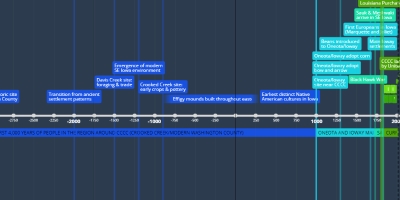jan 1, 900 BC - Crooked Creek site: early crops & pottery
Description:
Early pottery and ancient crops at Crooked Creek site 5 mi se of CCCC from 900 b.c.e.:One archaeological site discovered along Crooked Creek about 5 miles southeast of Camp was home to a community around 900 b.c.e. Archaeologists found remnants of some crops that were cultivated in Iowa since thousands of years ago, which included little barley, upright knotweed, may grass, marsh elder, goosefoot, sunflowers, summer and winter squash, and bottle gourds. Goosefoot is the only one of these that still commonly grows wild throughout eastern Iowa. People today still farm a few goosefoot varieties in some regions, but no longer in Iowa, and the same is true of sunflowers, which are mostly harvested in North and South Dakota now. Of all the crops domesticated and harvested by the people living here in ancient times, gourds and squashes are the only ones still found in the gardens of Southeast Iowa, and have been introduced all across the world since then.
The people at this nearby Crooked Creek site also made some of the earliest pottery in eastern Iowa, which was first introduced to the area around that time. Artifacts from another community along the Skunk River have also been found south of here in Henry County. Their artisanal and agricultural styles and methods did change over the generations though. Pottery from 200 c.e. was much more precise and detailed, with thick, elongated jars in fashion. By that time, people living here had begun growing tobacco to smoke with pipes or to flavor their meat. They also collected dogwood and sumac for these uses. Tobacco is no longer produced in Iowa, but both dogwood and sumac are still found around here. One of the campsites on the east side of Camp is named after the latter.
Added to timeline:
Date:
jan 1, 900 BC
Now
~ 2927 years ago
